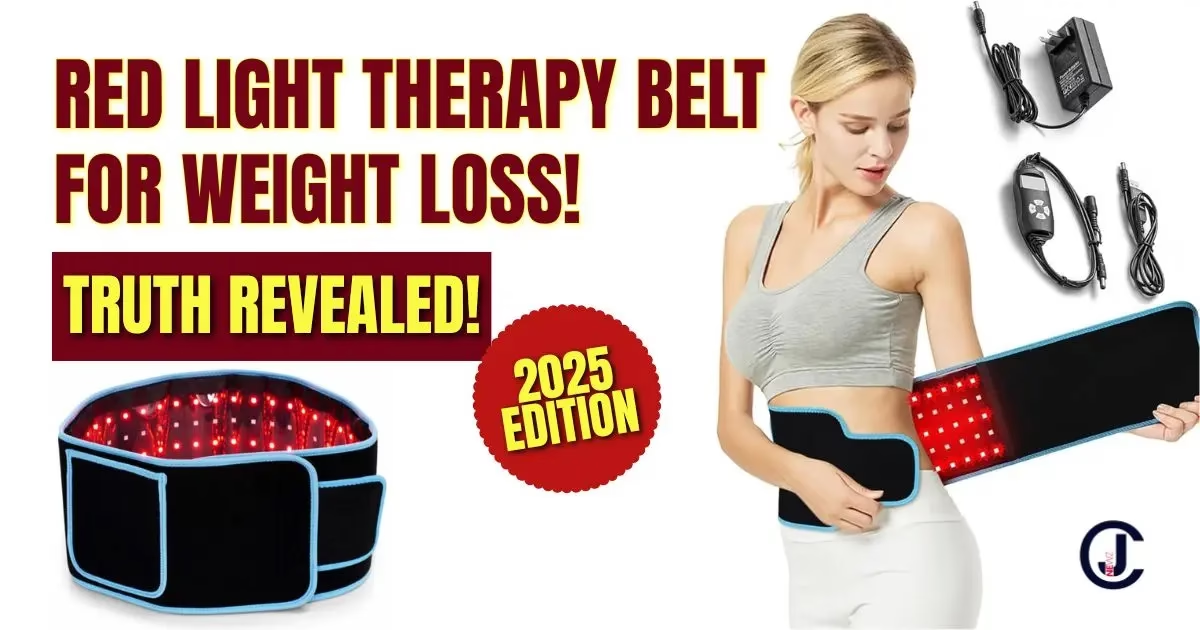Table of Contents
What’s All the Buzz About Red Light Therapy Belt For Weight Loss?
It seems as though Red Light Therapy Belt for Weight Loss is being flaunted for almost everything one can think of – from pain relief to fat loss-in the past few years. But do they really work? Or, are we looking at yet another form of so-called “wellness craze” from TikTok and Amazon?
In this article, we will clear up the confusion on red light therapy and the actual working of these belts, for what they are effective, and finally if your money should be spent on one.
What Is a Red Light Therapy Belt?
A belt for red light therapy is really a wearable device embedded with LEDs that specialize in putting out red and near-infrared light (generally at a wavelength somewhere in between 630 and 850 nanometers). The belts come flexible and are portable so they can be wrapped around a body part: waist, back, thighs, arms, or abdomen.
They’re often marketed to:
- Aid in weight loss
- Reduce inflammation
- Improve muscle recovery
- Relieve joint and back pain
- Boost skin health
The Science Behind Red Light Therapy: How It Works
Red light therapy is based on the idea of photobiomodulation—the process where certain wavelengths of light stimulate cell function.
Here’s what happens inside your body:
- Red and near-infrared light pass through the skin and reach cells and tissues.
- It stimulates the mitochondria, the powerhouses of cells, to produce more ATP or adenosine triphosphate, an energy form of cells.
- It promotes the speed of cellular repair, inhibition of inflammation, and tissue regeneration.
This process has been particularly under experimental observation in the medical and wellness contexts, with other applications such as in physical therapy offices, dermatological establishments, and space medicine (NASA tests this process for wound healing in space).
Red Light vs. Infrared: What’s the Difference?
Many therapy belts use both red and near-infrared light, but each plays a different role:
| Type of Light | Wavelength (nm) | Penetration Depth | Effect |
| Red Light | 620–660 | Surface of the skin | Stimulates collagen, reduces inflammation, supports skin health |
| Near-Infrared | 800–850 | Deeper tissues | Targets muscles, joints, and deep pain relief |
So, if a belt offers dual wavelengths, it’s more likely to cover both skin-level and deep-tissue benefits.
Also Read: Vitamin B12 Foods After 50: 12 Essential Sources You Need
What Are Red Light Therapy Belts Used For?

Let’s explore the main reasons people buy these belts—and what the science says:
1. Weight Loss and Fat Reduction
One of the biggest claims is that red light belts can melt away belly fat. Some research suggests that red and infrared light may stimulate fat cells to release lipids (fats), which the body then processes.
✅Supporting Evidence:
- Some clinical trials reported mild improvement in waist and hip measurements with repeated treatments.
- According to a study published in 2020 in Lasers in Medical Science, red light can help body_contouring when combined with exercise.
⚠️Reality Check:
- It cannot exactly be termed as a miracle fat burner.
- The effects are mild and tend to fade with time, unless combined with proper diet and exercise.
2. Pain Relief (Back, Joints, and Muscles)
Red light can reduce inflammation and promote tissue repair. Therefore, it will ease.
- Back pain
- Arthritis
- Sore muscles
- Joint stiffness
✅ Studies show significant pain reduction and increased mobility in patients with chronic pain after red light therapy.
3. Skin Benefits
Because red light promotes collagen production and increases circulation, it’s used to:
- Improve skin tone
- Reduce wrinkles
- Heal acne scars
While belts aren’t ideal for the face, many people use them on their neck, chest, or stretch marks.
4. Muscle Recovery
Athletes and fitness enthusiasts use red light belts to:
- Speed up recovery
- Reduce DOMS (Delayed Onset Muscle Soreness)
- Improve performance
Some studies show faster recovery in those using red light before or after workouts.
Do Red Light Therapy Belts Really Work? Let’s Talk Science
Here’s what current clinical studies and user data say:
✅Proven Benefits
- Pain relief: Especially for chronic back pain, arthritis, and muscle soreness.
- Improved blood circulation
- Faster healing of minor injuries
- Reduced inflammation
❌What It Doesn’t Do Miraculously
- Major weight loss (won’t replace diet/exercise)
- Instant skin transformation
- Permanent fat loss
Key takeaway: Red light therapy belts do work, but they’re not magic. They’re most effective when used consistently and in combination with a healthy lifestyle.
Before You Buy: What to Look for in a Red Light Therapy Belt
If you’re considering buying one, here are features to check:
1. Wavelength Range
Look for devices with dual wavelengths:
- 660 nm (red light)
- 850 nm (near-infrared)
2. Irradiance (Light Intensity)
Measured in mW/cm². Higher irradiance = deeper penetration. Aim for belts with ≥100 mW/cm².
3. Timer Settings & Heat Control
Quality belts come with built-in timers, adjustable intensity, and auto shut-off to avoid overheating.
4. Fit and Flexibility
Ensure the belt is adjustable and fits snugly around different body parts.
5. Safety Certification
Look for FDA-cleared or medical-grade belts. Avoid no-name brands with vague specs.
Top-Rated Red Light Therapy Belts in 2025
Here are a few brands users trust based on reviews and specs:
| Brand | Key Features | Price Range |
| LifePro Lumicure | 660 & 850nm, lightweight, good for back pain | $149–$189 |
| Hooga HG Wrap | Medical-grade LED, adjustable strap | $180–$200 |
| iRed Light Belt Pro | Deep tissue penetration, long battery | $200–$250 |
(Not sponsored, just well-reviewed options)
How to Use a Red Light Therapy Belt: Simple Guide
- Wrap the belt around the target area (e.g., waist, back, thigh).
- Set timer (start with 10–15 minutes).
- Use it 5–6 times per week consistently.
- Don’t use over open wounds, tattoos, or if you have photosensitive conditions.
🔒 Safety Tip: Always read the manual and avoid overexposure. Too much red light can cause temporary skin sensitivity.
Before and After: What Results Can You Expect?
Most users report:
- Pain relief within 2–3 sessions
- Mild fat reduction after 2–3 weeks
- Improved skin tone after 1 month
- Muscle recovery faster than without therapy
But again, consistency matters more than intensity. Results vary based on body type, usage frequency, and health status.
Red Light Therapy Belt: Pros and Cons
✅Pros
- Non-invasive and drug-free
- Can be used at home
- Aids recovery and relaxation
- Multi-functional (weight, pain, skin)
❌Cons
- Expensive upfront
- Not instant or dramatic
- Needs consistent use
- Varying product quality online
FAQs About Red Light Therapy Belts
Q1: Are red light belts safe?
Yes, when used properly. Just don’t overdo sessions or use on eyes or sensitive skin without protection.
Q2: How long does it take to see results?
Pain relief may be quick; fat loss and skin improvement can take 3–6 weeks.
Q3: Can red light therapy burn your skin?
Not if used correctly. Overuse or faulty devices may cause warmth, but not burns.
Final Thoughts: Are Red Light Therapy Belts Worth It?
If you are looking to stay non-invasive in support of your wellness interests, be it fat loss, pain relief, or muscle recovery, the red light therapy belt represents an investment worth considering. Now, while it does not perform miracles, it has the sciences backing up its effectiveness if used together with exercise and healthy habits. Just stay keen to pick a quality belt and stick to all the safety guidelines.

